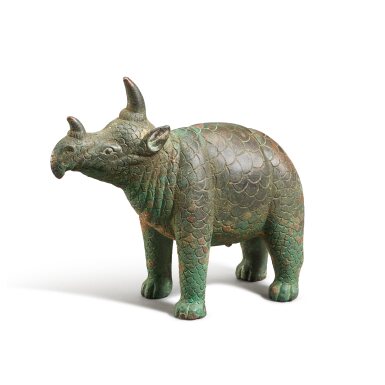Important Chinese Art
Important Chinese Art

Property from an Important Japanese Collection | 日本顯赫收藏
A rare small bronze figure of a rhinoceros, Tang dynasty | 唐 青銅犀牛
Auction Closed
October 9, 10:57 AM GMT
Estimate
800,000 - 1,000,000 HKD
Lot Details
Description
Property from an Important Japanese Collection
A rare small bronze figure of a rhinoceros,
Tang dynasty
日本顯赫收藏
唐 青銅犀牛
12.2 cm
The results of Oxford Authentication Ltd. thermoluminescence test no. C206g75 are consistent with the dating of this lot.
Oxford Authentication Ltd公司熱釋光檢測結果(編號C206g75)顯示年代與本拍品年代一致。
Christie's New York, 28 March 1996, lot 273.
紐約佳士得1996年3月28日,編號273
Doreen Stoneham, 'Thermoluminescence Testing of Ceramic Works of Art', Orientations, June 1990, fig. 4.
Doreen Stoneham,〈Thermoluminescence Testing of Ceramic Works of Art〉,《Orientations》,1990年6月,圖4
Remarkable for its sculptural excellence and naturalistic portrayal, the present rhinoceros is likely to be depicting the two-horned Sumatran rhinoceros, which were once native to ancient China. Its existence is attested by ancient literature references and archaeological evidence. For example, rhinoceros bones attributed to the Shang dynasty had been unearthed in Anyang, Henan province in 1949, and some of the oracle bone inscriptions mentioned the burning of forests to hunt for rhinoceros. Evidently, capturing rhinoceroses and sacrificing them during rituals was a significant state event during the Bronze Age. Armour made from rhinoceros hide was also admired by warriors during the Spring and Autumn period. Due to the large-scale hunting, rhinoceros, a wild animal with low fertility, rapidly declined in population and largely disappeared by the late Western Han dynasty.
Despite the apparent local extinction of the rhinoceros by the Tang dynasty, their image persisted and were considered majestic and auspicious, as exemplified by a pair of monumental stone sculptures of rhinoceros guarding the spirit road of the founding emperor of the Tang dynasty, Gao Zu (566-635), one of which is now preserved in the Xi’an Beilin Museum. According to Edward H. Schafer in The Golden Peaches of Samarkand, Berkeley and Los Angeles, 1963, pp. 83-4, tamed rhinoceroses were brought by foreign embassies and presented to the Tang court, some were even trained to perform during palace entertainments at the court of Emperor Xuanzong (r. 713-756) and were kept in captivity in the imperial park at Chang’an.
Bronze figures of rhinoceros are exceptionally rare, with only a handful of surviving known examples. Compare an almost identical figure but with a different treatment of the skin, being the other only known example of this type, sold at Christie’s London, 6th November 2007, lot 141; and a related gilt-bronze recumbent rhinoceros with similar scallop-patterned skin, from the Dr Carl Kempe Collection, sold at Christie’s London, 10th November 2015, lot 155. For other Tang metalwares depicting rhinoceros, see a pair of parcel-gilt silver dishes, again from the Dr Carl Kempe Collection, sold in our London rooms, 14th May 2008, lots 59 and 60; the former recently sold again at Christie’s New York, 23rd September 2021, lot 708; the latter in the Meiyintang Collection, illustrated in Giuseppe Eskenazi in collaboration with Hajni Elias, A Dealer’s Hand. The Chinese Art World Through the Eyes of Giuseppe Eskenazi, London, 2012; Chinese version, Shanghai, 2015, reprint, 2017, fig. 79. See also a gilt-copper repoussé ‘rhinoceros and foreigners’ plaque from the collection of Sam and Myrna Myers, sold in our London rooms, 4th November 2021, lot 346.
Only two bronze rhinoceroses from earlier dynasties are known to have survived: a late Shang rhinoceros zun from the Avery Brundage Collection and now preserved in the Asian Art Museum of San Francisco (object no.: B60B1+); and a Western Han gold and silver-inlaid rhinoceros zun preserved in the National Museum of China, Beijing, illustrated in The Great Bronze Age of China, Metropolitan Museum of Art, New York, 1980, cat. no. 93.
